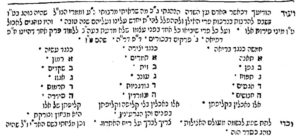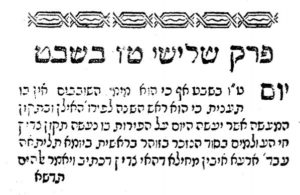This Wednesday evening we mark Tu b’Shevat, the “New Year for Trees”. While originally an obscure and mostly-unobserved holiday, Tu b’Shevat took on greater significance among the Kabbalists of the 16th and 17th centuries. As is well-known, an entire Tu b’Shevat “seder” emerged, complete with four cups of wine and a Haggadah of sorts. What is not so well-known is where this Tu b’Shevat seder actually came from, and the mystical foundations upon which it stands.
It is commonly said that the Tu b’Shevat seder was instituted by the great Arizal (Rabbi Itzchak Luria, 1534-1572). Yet, nowhere in the official canon of the Arizal’s teachings is there any mention of a Tu b’Shevat seder. Having said that, it does not mean he didn’t come up with it. The official canon of Kitvei haAri was composed by his main disciple Rabbi Chaim Vital (1543-1620), with some serious emendations by others, including his son, Rabbi Shmuel Vital (1598-1677). However, Rabbi Vital was not the only disciple, and others wrote down and taught the Arizal’s teachings, too. In fact, there was something of a struggle following the Arizal’s death among his students to determine who was truly the main disciple, with many favouring Rabbi Yosef ibn Tabul (c. 1545-1610).
Another popular belief is that the Tu b’Shevat seder originates in a somewhat controversial text called Chemdat Yamim, first published in 1731. The author remained anonymous, and a few of the teachings in the text were questionable, leading to some fierce debates regarding whether this was a kosher work or not. Some held that it was written by a follower of the false messiah Shabbatai Tzvi (1626-1676), and perhaps even by his main supporter and enabler, Nathan of Gaza (1643-1680). However, the evidence for this claim is not especially strong, and many great authorities ruled that Chemdat Yamim is certainly a kosher text. In recent times, the text was especially beloved by Rav Ovadia Yosef. (For a full analysis of the controversy, see here.) In any case, the Tu b’Shevat seder actually predates Chemdat Yamim and comes from a source that is totally anti-Shabbatean!
A Mystical Seder
The earliest written mention of the Tu b’Shevat seder comes from a sefer first published three years before Chemdat Yamim, in 1728: Birkat Eliyahu by Rabbi Eliyahu of Ulyanov. (This Ulyanov is not to be confused with the modern-day city of Ulyanov, or Ulyanovsk, in Russia, which was only recently named thus in honour of Lenin, whose original surname was Ulyanov!) Rabbi Eliyahu cites his contemporary, Rabbi Moshe Hagiz of Jerusalem (c. 1671-1750), regarding a Tu b’Shevat seder. There, Rabbi Hagiz clearly states that he himself instituted this custom, based on the words of his teachers.
Rabbi Hagiz’ first teacher was his father, Rabbi Yakov Hagiz of Morocco (1620-1674), a fierce anti-Shabbatean who actually excommunicated Shabbatai Tzvi! Following his father’s early death, Rabbi Hagiz’ studies were overseen by his maternal grandfather, Rabbi Moshe “Magen” Galante (1621-1689), whose own grandfather, Rabbi Moshe Galante of Tzfat (d. 1608) was a disciple of the Arizal! And so, there is a clear chain of tradition from the Arizal down to Rabbi Moshe Hagiz, who first spoke of a Tu b’Shevat seder and formally established it. Here are the words of Rabbi Hagiz, as quoted by Birkat Eliyahu:
…as it is written, “man is a tree of the field” [Deuteronomy 20:19], and so I established a custom, based on what I have seen from my rabbis (named previously), and my teacher [ie. Rabbi Moshe Galante] who, on Tu b’Shevat, would customarily recite many blessings on fruits and pray to Hashem to renew for us a good year. And they would eat these fifteen fruits…
Rabbi Hagiz goes on to list the fruits and briefly explain why they are eaten, based on Kabbalah. The first five fruits are the fig, grape, apple, pear, and quince. These fruits have a thin outer peel that can be eaten along with the fruit. The second set includes dates, olives, and cherries—fruits that don’t have a peel but do have a hard pit inside which cannot be eaten. (The other two in this set are called an ‘onev and an ‘uzrad—which I am unable to adequately translate!) The final set of five includes the pomegranate, almonds, and walnuts (or hazelnuts). These are fruits which have a tough outer peel or shell that must be broken through to extract the fruit. (Once again, the other two fruits listed, turmus and sidrah, are difficult to translate.)
Each of these sets of fruits corresponds to one of the four universes or dimensions. The first set corresponds to Beriah, the second set to Yetzirah, and the third set to Asiyah. In order to connect the soul to the highest realm of Atzilut, Rabbi Hagiz says one should smell (and make a blessing on) an etrog. All of this needs some further elucidation.
Recall that the entire Kabbalah of the Arizal is based on the concept of tikkun, “rectification”. One of the key ways of rectifying the world around us is by removing the spiritual “husks”, kelipot, to free the sparks of holiness, nitzotzot, trapped inside. In this lowest world of Asiyah which we inhabit, the kelipot are generally very strong. They are like those fruits with the tough outer shell. The higher realm of Yetzirah needs some rectification, too. However, the kelipah there is much weaker and smaller, like the second set of fruits which are mostly edible on the outside but have a small, inedible pit within. Higher still, in the realm of Beriah, there is almost no kelipah at all, hence the fruits that can be eaten entirely, even with their thin peel and small seeds. The highest realm of Atzilut is pure divine emanation, with no hint of evil whatsoever. This corresponds to a fruit that needs no consumption at all, but only to be smelled.
This alludes back to the Garden of Eden, where man sinned by using four of five senses: Adam and Eve saw the Forbidden Fruit, heard the evil advice of the Serpent, touched the Fruit, and then tasted it—but did not smell it! The sense of smell remained pure and needs no rectification. Indeed, one can sin with all the other senses, but there is no way to sin with one’s nose. (At least not through one of its natural functions.) This is why the greatest and most powerful mitzvah of all was the Temple incense service, and also why Mashiach will be able to judge through his sense of smell (Sanhedrin 93b, based on Isaiah 11:3).
Today, it is difficult to find an etrog in most places at this time of year, so perhaps another citrus fruit will do. Scientifically-speaking, the three “original” citrus fruits from which all others are hybridized are the etrog (or citron), the pomelo, and the mandarin. So, if one were looking for a proper etrog substitute (as close as possible), a pomelo or a mandarin would be best. On that note, fitting substitutes for the first set of all-edible Beriah fruits would be blueberries and blackberries. Substitutes for the second set would be peaches, apricots, and plums. For the third set: oranges, kiwis, and coconuts.
It is important to note that bananas, melons, strawberries, pineapples, and peanuts would not count since these have the blessing of bore pri ha’adamah, and the seder specifically requires fruits from trees with the ha’etz blessing. (Interestingly, that controversial Chemdat Yamim work does mention tutim, strawberries, as being appropriate all-edible Beriah fruits for the seder. However, it strangely also lists lemons and etrogs in that category!)
Finally, Rabbi Hagiz concludes his passage with an affirmation that this Tu b’Shevat seder of 15 fruits in three sets, plus one to smell, is the proper way to do it, as instituted by the Arizal. It might be needless to say that there are 15 fruits in particular to tie directly into Tu b’Shevat, which is the 15th of Shevat. He also mentions that it is proper to study the following tractates of Mishnah during the seder, one for each fruit: the eight chapters of Pe’ah, the three chapters of Bikkurim, and the four chapters of Rosh Hashanah—altogether this makes for 15 chapters of Mishnah. Most versions of Bikkurim nowadays actually have four chapters, which is okay because there is a 16th fruit to smell anyway!
Four Cups of Wine?
Many Tu b’Shevat seder “haggadahs” today (like this one) also speak of drinking four cups of wine. As we have seen, this was not in the original seder as brought down by Rabbi Hagiz. This custom does indeed come from Chemdat Yamim, which gives a much fuller account of the Tu b’Shevat seder, spanning several pages (see Part II, section on Shovavim, Chapter 3, Tu b’Shevat), as well as another anonymous work published around the same time called Pri Etz Hadar. Much of what they say overlaps with Rabbi Hagiz’ account, with lots of extras. For example, in addition to studying Mishnah, there is a detailed order of verses from the Tanakh to be recited, starting with the first three days of Creation, along with passages from the Zohar.
In both Pri Etz Hadar and Chemdat Yamim, the meal opens with something made of wheat. This is followed by olives, dates, and wine. The first cup is entirely white wine. After this, one eats a fig, then pomegranate, etrog, and apple. One then drinks another cup of white wine, now with a little bit of red wine mixed in. This is followed by walnuts, then hazelnuts or almonds, carobs, and pears. At this point, one drinks a third cup of wine that is half white and half red. Then it is that ‘uzrad again (possibly a medlar or crabapple of some sort) and a number of other hard-to-translate fruits. The seder ends with a cup of red wine, with a little bit of white wine mixed in.
The four cups are, of course, meant to mirror the four cups of the Pesach seder. The latter are derived from the Torah’s verses describing redemption from Egypt. On Pesach we drink four cups of wine to commemorate the First Redemption. The four cups of wine on Tu b’Shevat are meant to get us thinking about the Final Redemption. (For more on this, see ‘Tu b’Shevat: The Prime Ministers of Israel and the Coming of Mashiach’ in Garments of Light, Volume One.) It is worth mentioning that the Talmud says the greatest sign of the coming Final Redemption is when Israel overflows with an abundance of fruit (Sanhedrin 98a, based on Ezekiel 36:8).
Lastly, Chemdat Yamim gives a permutation of God’s Name to meditate upon for each fruit, along with an additional text to study, usually from the Zohar. It says that each person should maximize how many different fruits they eat, though the minimum should be twelve. It cites a Talmudic passage which teaches that God will hold a person accountable for every (kosher) delight they could have partaken in, but didn’t. Judaism does not preach ascetism—God made this wonderful world full of delights for us! He wants us to enjoy His work. So, we should delight in all kinds of sweet, delicious, and exotic fruits, and never cease to marvel at God’s remarkable creations.




Pingback: Jews and Christmas Trees | Mayim Achronim
Pingback: Secrets of Tu b’Shevat (Video) | Mayim Achronim